2. Light, Vibrations and Us
In this section we shall examine the mechanics of seeing colour. This entails two different factors - the physiological method by which the human eye responds to particular types of stimulation; and the perceptive, memory and interpretative functions of the human mind.
The Human Eye:
We have already discussed the vibrational quality of light briefly. You’ll remember that light is thought to be composed of very rapid vibrational pulses. As these pulses hit an object (a pattern of more solid and concentrated vibrations) their composition is altered. Some of the pulses are absorbed into the object, and others bounce off its face at new angles. These last are reflected vibrations, and will now be travelling at a different speed, because of the effect of their impact upon the more solid object. Reflected vibrations come into contact with your eyes. We never come into contact with pure, unreflected light. If we did we would certainly be blinded, for the light radiated by the Sun is extremely powerful and concentrated. Even on a sunny day, when we squint at the light, or wear sunglasses, we are experiencing filtered and reflected light. Before the Sun’s rays reach the Earth they have passed through our atmosphere, which has absorbed and reflected much of their power. This is why astronauts wear suits which incorporate a tinted and reflective visor over the face - if they experience sunlight without the diffusing effect of the planet’s atmosphere they must protect their eyes from the full force of the Sun’s light.

The human eye is a complex globe-like structure, most of which is contained within the skull (see image above) On the exposed front portion there is a hole, called the pupil, covered by a lens which is set within the iris.
The iris is able to contract or dilate over the lens, thereby controlling the amount of light which passes through the lens aperture. In strong light, the iris will expand, reducing pupil size and limiting the amount of light that falls upon the retina, which lines the inner back surface of the eye. In dim light the iris will shrink back, allowing the pupil greater dilation in order to allow as much of the poor light as possible to pass onto the retina.
The retina contains many thousands of light-sensitive nerve-endings upon which the light passing through the pupil falls. These nerve endings are called rods and cones. (See image below)
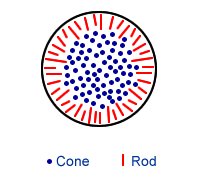
Rods lie mostly around the periphery of the retina, and are activated only by the vibrations of dim light, when the pupil is open wide in order to pass through as much light as possible. Everything appears to be a blue grey colour to rods. Therefore they operate mostly in night vision.
Cones are mostly concentrated in the centre of the retina. Like rods, cones are stimulated when vibrations of light fall upon them. However, cones are sensitive to specific vibrations, and will only respond to certain vibrational frequencies, according to their type. These variations of response fall broadly into three particular categories. For instance, Cone Type A will come into operation only when Type A frequency is present in the pattern of light which passes through the pupil and onto the retina. When Type B light frequency passes through the lens, Cone Type A remains dormant, but Cones Type B are activated. When frequencies of light pass through the lens which border on the dividing line between types, some of both Cone Types react; this dual response also occurs when more than one reflected frequency type passes through the lens at the same time - and it must be noted that this is the usual state of affairs.
This is because, under normal circumstances, our eyes receive the reflected vibrations from many different objects and surfaces at one time. Look up now and check how many different things you can see at a glance. You’ll see what I mean.
Without venturing too far into the field of human perception, for now, it must be recognised that eyes do not see colour. They see particular light frequencies. In order to differentiate these varied light frequencies, man has arbitrarily named them in a system we now call colour. For this reason, the cones in our eyes are known generally by the names applied to the ‘colours’ we have assigned to their particular light frequency. Therefore the three different types of cone are known as:
Red-sensitive cones
Yellow/green-sensitive cones
Blue-sensitive cones
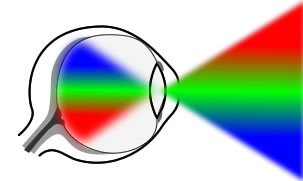
These names loosely describe the word we have applied to the specific reaction we have when that set of cones is activated. From this, you will see that colour, in fact, has no material existence... it is simply a helpful peg on which to hang our hats. It is more simple to say ‘I see blue’ than to say ‘I see a particular vibration of light which stimulates certain cones in my retina, and I recognise this pattern to be what we all call blue’. For ease of communication, we will in future refer to these nerves by their arbitrarily applied names. However never forget that we are using a shorthand communication device, designed to simplify the process of learning. It is the type of light which is important, not the colour!
You will understand now that when you look at an object which reflects back red frequency light, the red-sensitive cones in your eye will be activated, and you will ‘see red’. All other colours and variations in tonal shade are produced by subtle variations in the composition of a given light ray - for instance, turquoise is recognised by mixed response from Yellow/Green cones and Blue cones being stimulated simultaneously - and of course the tone of the turquoise you see will depend on the actual mix and balance of activated cones.
It is interesting to note that man’s perception of colour seems to have developed through the process of evolution. There is evidence to suggest that a caveman had far less clearly defined colour perception than was exhibited some thousands of years later by the Egyptian peoples. The first evidence of full-spectrum colour comprehension and reproduction is left for us by the artistic relics of Ancient Egypt. Even here, there are positive indications that human perception of colour was nowhere near as infinitely varied as it is today. Even now, there are areas of difficulty in the identification of colours varying from light blue through indigo to violet, which would suggest that our ability to either perceive or identify these colours is still open to enormous expansion and development. When you next see a painted rainbow, take a look and see if it includes indigo. Many do not. Whether this limited vision is physiological or spiritual, we shall leave you to decide.
It is also important to remember that the number of cones which respond to a particular colour vibration varies from person to person - and even from eye to eye. You can try this for yourself by looking at a brightly coloured object in strong light. Look at it first with the right eye covered, and then with the left. You will probably notice that you see slightly different shades of the same colour with each eye.
A final note must be made here about people whose perception of colour varies from what is considered ‘normal’ though from what I have already said you will understand that ‘normal’ does not exist). These people are called ‘colour-blind’; in fact, this name is misleading. Very few people see the world in black, white and shades of grey. Most instances of colour-blindness are better described as inversions of particular colours - like seeing red where most people would say they see green, for instance. It is important to realise that such people experience colour in exactly the same way as everyone else; whilst they may see green where you see red, since they have always been told to call what is actually seen as green red, they are none the wiser until somebody conducts an infra-red light test upon them and they cannot perceive any light at all. Otherwise a ‘colour-blind’ person’s reactions and associations are all entirely comparable. Furthermore they are still experiencing the vibrational effects, which do not change regardless of any deficiency in functional operation of their cones.
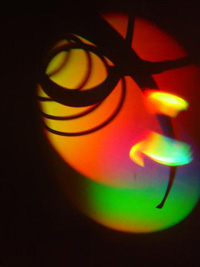
Because the emotional response to a colour is created not by what it looks like, but by the reaction to the impact of a certain frequency, a person with impaired sight will react in a similar fashion. People with severely impaired sight, or no sight at all, still receive light vibrations in more subtle ways than people who can see - for instance, as they impact upon the aura and the skin - but their interpretation of those vibrations is perhaps more limited.
Some ideas about human perception:
The human brain is, as we all know, an immensely powerful data-collector and storage mechanism. It processes a phenomenal amount of information in each and every second of our existence, monitoring, filing and sorting thousands of reports sent by our body and our external senses. It maintains normal body functions like muscular actions, breathing, digestion, temperature, etc., with no conscious guidance or instruction. It presents some information for conscious appraisal and action - as is happening right now, as you read this lesson.
You are aware of the basics about your surroundings, of external noise, of your own body (though many of its functions are not in conscious awareness), and so on. Right now, perhaps the only thing which is actually being consciously absorbed and retained is the information on this page. But, should there be an unusual noise, your brain would immediately offer that up for appraisal, and to collect any necessary instruction. So your brain deals with most of the uniform functions, and judges what should be simply stored away, and what should be given greater consideration. This is one reason why people tend to be attracted by something ‘new’... because instead of simply absorbing and filing information, the brain presents the unfamiliar for recognition and directive guidance to the mind. So, once you are familiar with something you have an unconscious way of filing it away in case you need it later. But something new has to be considered and directed to the appropriate part of memory.
The memory part of your brain is absolutely amazing in its functions and capabilities. This is where you store all of that familiar data, until you need it later. It has often been said that every single thing which crosses your path in life is stored in your memory. Some time ago an experiment was staged to test witness reaction after a staged car accident. All the witnesses knew that they were to be part of an experiment beforehand. Afterwards, when they were interviewed to see what they remembered of the situation, none of them were able to get all the details of car colour, make, movement and actual events correct. Yet, when they were hypnotised, they were each able to give a complete and accurate account of events.
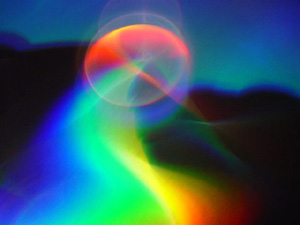
So what is this amazing thing, memory? How does it work? These two questions have already been the subject of numerous books, so we shall be able to do little more than take the briefest of glimpses in these pages.
Have you ever thought about the way in which you build up knowledge and store information. Perhaps it goes something like this - in childhood you would have been exposed to huge amounts of information - this in part because when we come into the world, we have to acquaint ourselves with it. We build up a network of understanding, a treasure house of images, sounds, smells, and feelings, which are linked together with intricate triggers.
It is these triggers which act as labels to each of the memories we store. Language is critically important here, because it is by means of words that we label and link. But we do use other means of inter-relating material too - any sense or feeling, for instance, often triggers other associations. However, in the end, particularly if we want to relay information to another person, we must use words. To explore this linkage, try this exercise now:
Take a blank piece of paper, and write upon it the word RED. Now just look at the word, and watch what happens. You will begin to make associations. You might end up with a list which reads RED HOT STOP GREEN GO ROADS... for instance. Or any other of a thousand combinations. Each word will act as a trigger to a series of other chains of associations too. This is your own mind hopping across the material which is stored up in your memory.
Just for fun, you might also like to try another experiment that causes some quite interesting reactions because it ‘trips’ memory up - take a blue pen and write ‘yellow’ in big letters - or even better, paint it. You’ll find that your mind determinedly keeps rejecting the mismatch of information! This is an interesting method of looking at the way your memory stores information, and how it brings the unfamiliar to your notice.
Psychological research has identified colour as one of our major methods of recognition. We observe the size, shape, texture and colour of a given object, cross-match it against our currently stored images and find an appropriate box to slip it into. In this way, we learn to exist in our world, and to have a shared comprehension with other human beings.
So, colour has great influence on our interpretation and perception of the outside world. It helps us assimilate observations, and has relevance to all visual functions. It also cross-references observations from all other senses.
So far we have talked about the mechanical functions of the brain, and the way that it works with the mind to help us. However, these issues form only the outer skin of the human mentality. At our very core are the emotions which power us, the instincts that drive us, and the spark of light that makes us all that we are....for better or for worse.
And it is here, in the inner realms, that colour has its greatest meaning. Research has shown that humans have emotional reactions to given colours. Furthermore, we have found that we actually respond in broadly the same way to the same colour. Particular emotions are stimulated by particular colours - just as particular cones are stimulated. This is an unconscious and almost automatic response that we all have.
So what can this mean? How does it happen? We have to go back to the vibrationery theory of the existence of matter for an explanation. Remember, all matter is composed of vibrational patterns of lesser or greater density. Electrons, atoms and molecules form matter. These vibrate together in a given pattern in order to create different types of matter. If mass is analysed down to its basic molecular structure, patterns of similarity emerge. For instance, by analysing the structure of two separate pieces of wood, we will find relatively small differences in the basic molecular structure of each. Therefore we must conclude that pieces of wood are, broadly speaking, the same.
So it is with living creatures. We are merely masses of atoms bound together in a particular form. All of our muscles, tissues and bones are constructed in a roughly similar fashion. And so, within certain broad parameters, we can safely say that people are all the same - or, at least, that they are constructed materially in the same fashion. The force which holds all our atoms together, and helps to prevents the odd molecule from flying off, may be considered as a vibrational pattern which is ‘human’.
So there is a given band of vibrational pattern which contains within it the ‘human being’. Whilst there may be individual variations inside the frequency band, the overall band belongs to our race, much as does an allocated radio frequency belong to a particular radio station.
We also know that light has a particular range of vibration. When one vibration comes into contact with a different vibration, there is a predictable reaction which can be repeated again and again. The impact of the two vibrations will generally result in the same outcome. So every time a person in exposed to, say, the colour red ,a specific reaction will occur. Of course, there will be small differences in the speed and intensity of response, and even in the reaction caused by that response, the reaction will always emerge. These slight variations are caused by the individual differences in the human part of the equation. We do not only register vibrations of light with our eyes. They impact upon our skin as well. You can test this for yourself, by taking a lamp with a high wattage bulb in it. Position the lamp so that you can put your hand inside its light, without being close enough to feel the heat of the bulb.
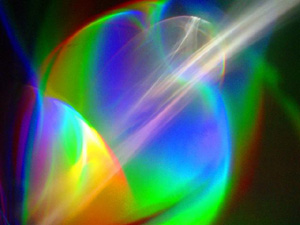
Concentrate on the sensations you experience when your hand is in the lamplight. You will be able to feel tiny impacts on your skin. Then move your hand into darkness and examine the sensations you experience there. They will differ marginally from the feelings when your hand was illuminated.
Like any other material which is more dense in its vibrational patterns than is light, your skin is penetrated by some elements of the ray of light, and it reflects other elements away. If you look at your hand, you will also observe the results of light reflecting away from it - you will see the colour of your own skin.
Everybody can feel light impacting upon them. This is one reason that blind people can still interpret and react to colour in a roughly similar fashion to those people who can see.
One of the fascinating things that the ideas put forward in this section introduces is the concept that all matter is simply different collections of the same thing - expressed as widely differing types of object, yet all still composed of the same thing. One could say - everything is the same, in essence. It just expresses itself differently!
